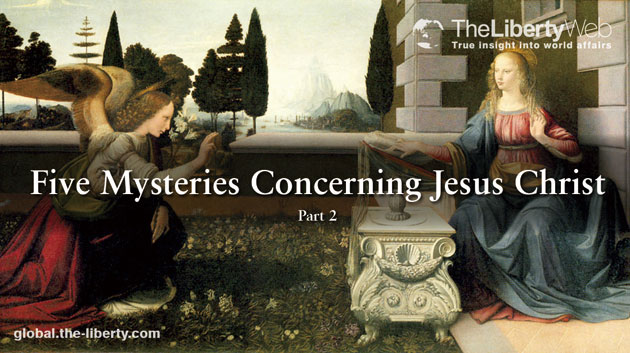Five Mysteries Concerning Jesus Christ (Part 2)
1. Was Jesus’ Birth a “Virgin Birth” or “From Normal Conjugal Relations”?
─In the Essene Sect, Pre-Marital Pregnancy Was Called “a Virgin Becoming Pregnant”.
A Shocking Discovery “A Box Containing the Bones of Jesus’ Younger Brother”
In the Gospel of Matthew, the following words of people from his home town are recorded: “This person (Jesus) is probably a carpenter’s son. Probably his mother is named Mary and his brothers are Jacob, Joseph, Simon, and Judah.” The Roman Catholic Church, so that it can assert Jesus’ godhood and believe that his mother Mary was “eternally a virgin”, teaches that these “brothers” were Jesus’ cousins.
However, an archaeological discovery was made in Israel in April 2002 that shook this doctrine. On a funerary box in the collection of an antique lover was engraved the shocking inscription, “Jacob. The son of Joseph and younger brother of Jesus”. The argument still continues as to whether this truly is the funerary box of Jesus’ brother, but if Jesus really did have a younger brother, this calls into question not only whether Mary was eternally a virgin but also Jesus’ “virgin birth”.
The Bride Was Pregnant at the Time of the Wedding.
A look at the marriage system of the Jewish Essene sect, to which Jesus and Mary belonged, also contradicts the “virgin birth”.
The Essenes are a sect that led a communal life similar to that in a monastery. Documents such as the “Dead Sea Scrolls” found at Qumran in the 1940s give a clear picture of their day-to-day routines at the time.
According to those documents, their custom was that men and women were permitted to have sexual relations after a provisional marriage ceremony and the formal wedding ceremony was held once the woman was three months pregnant. In other words, the bride was pregnant at the time of the formal wedding ceremony (see note 3).
Moreover, although the provisional wedding was preceded by an engagement lasting several years during which sexual relations were forbidden, there were some couples which broke this ban and things went as far as pregnancy. At such times, as a matter of honor, the expression “a virgin has become pregnant” was used.
Even today, it is not particularly uncommon for the bride to be pregnant at the wedding. We should probably assume that Jesus was born as the result of normal conjugal relations according to the distinctive marital customs of the Essenes (see note 4).
Just as Shakyamuni’s greatness and people’s faith in him are not shaken even if Buddhists do not believe that Shakyamuni was born from Maya’s right side, neither should anything about Jesus’ greatness change even if he was born from an ordinary married couple.
Note 3: Jesus the Man (by Barbara Thiering), The Meaning of the Dead Sea Scrolls (by Powell Davies), The Dead Sea Scrolls Today (by James C. Vanderkam), etc.
Note 4: Only the Gospels of Matthew and Luke touch upon the “virgin birth”; it is not mentioned in the Gospels of Mark or John, or in other documents. The story of the “virgin birth” may be said to be exceptional, even in the Bible.
2. What Was Jesus Doing During his 17 Blank Years?
─Jesus Studied Buddhism and the Religion of Egypt in Their Respective Homelands
An Ancient Document Is Still in Existence in Tibet named “The Life of Jesus”
In the Bible, there is nothing mentioned at all about Jesus’ actions during a 17-year period of his youth. However, there is an ancient manuscript entitled The Life of Issa in a Tibetan monastery that says that Jesus did spiritual training in India. This document was first revealed to the world in 1894 by the Russian journalist Notovitch. “Issa” was Jesus and this ancient manuscript contained amazing details about how Jesus went to India at the age of 14 and studied Buddhism in Shakyamuni’s birthplace of Kapilavastu. He also studied Zoroastrianism in Persia.
Notovitch was heavily criticized after he made this document public, but over the next few decades eminent Hindu scholars, archaeologists, and anthropologists confirmed the same manuscript and various oral traditions concerning Jesus in India and Tibet. There is a very strong possibility that Jesus studied Buddhism.
Jesus Inherited the Legacy of Egypt
It is not just a matter of earthly records. Accounts in the spirit world back up these stories as well. According to works such as The Golden Laws based on records in the spirit world (see note 5), when Jesus was 13 he was taken by a young Essene teacher to spend some time in Egypt. At the age of 16 he travelled with one of the leaders to West India and also, around the age of 22~23, he once again spent two or three years in Egypt (see note 6). During this period, he certainly studied Buddhism and Zoroastrianism in those places.
Karl Luckert, Professor Emeritus at Southwest Missouri State University, the author of Egyptian Light and Hebrew Fir, is one of the people who assert that “Jesus learned about Egyptian religion”. In an interview for this article he told us, “It says in the Bible that Jesus fled to Egypt for a while as a child, but I think we can assume that he later returned to Egypt and studied its religion. Jesus’ teachings have such a strong connection with the theological legacy of Egypt.”
Jesus went to the theologically advanced countries of those times, such as India and Egypt, where he imbibed the essence of Buddhism and Egyptian religion while his own original thinking crystallized.
Note 5: “Akashic records” These store the past and future history of humankind.
Note 6: See The Golden Laws (written by Ryuho Okawa and published by IRH Press).
3. Was Jesus “Celibate” or “Married”?
─There Is “Evidence” in the Bible as Well That Mary Magdalene Was His “Partner”
His Relationship With Mary Is Made Clear in the Apocrypha
“The Da Vinci Code” presents a verse from the apocryphal Gospel of Philip as one piece of evidence in support of the marriage of Jesus Christ and Mary.
“The companion (partner) of the Saviour was Mary Magdalene. Christ loved her more than the other disciples and often kissed her. The other disciples were offended to see this and became angry. They asked, “Why do you love her so much more than us?” The Savior replied, “Why do I not love you like I love her?” (See note 7)
The word used here to describe Mary Magdalene is the Greek one “koinonos” which also means “partner”. Simply reading the context, the relationship between Jesus and Mary Magdalene is clear.
Was Jesus the Bridegroom at “the Wedding at Cana”?
Sasagu Arai, Professor Emeritus at Tokyo University and a leading authority on the Gnostic writings of the Apocrypha, including the Gospel of Philip, explains, “Even without anything from the Apocrypha, it can be clearly stated from the Biblical canon that the two of them had a special relationship”.
“In the resurrection scene in The Gospel of John where Jesus appears before Mary Magdalene, the usual translation is that Jesus said to Mary, “Touch me not” but in fact the accurate translation is, “Stop holding on to me”. In other words, he unclasped her arms from around himself. Thus, the relationship between Mary Magdalene and Jesus was one where close physical contact was permitted.”
Professor Arai conjectures that in later days, when Jesus came to be venerated as the Son of God, the human tradition in which he had an intimate relationship with a particular woman had to be obliterated. However, there still remain fragments that could not be erased from the Biblical canon.
His theory is that “the wedding at Cana” in the Gospel of John is one such scene. Strangely enough, there is no mention in the Bible of whose wedding this was, and he says that it might have in fact been Jesus himself who was the bridegroom. Professor Arai says the fact that Jesus is urged by his mother Mary at the wedding to provide more wine when it has run out, is proof that Jesus was not a guest but was the bridegroom hosting the wedding.
This is when Jesus performed his first “miracle”, turning water into wine, and according to the Bible the steward told the “bridegroom” “you have saved the best wine till last”. He can only interpret this statement as Jesus and the “bridegroom” are one and the same person (see note 8).
Not just the Apocrypha but also the Bible itself indicates that Jesus was married and implicitly “proves” that his partner was Mary Magdalene.
This may be labelled “blasphemy” from the perspective of Christian doctrine, but even if Jesus were married, it would not be a denial of the fact that he was “Jesus Son of God”.
Note 7: From The Mystery of Magdalene and John.
Note 8: To begin with, marriage was practically a duty for Jewish men at the time of Jesus. In some places in the Bible, Jesus is addressed as “Rabbi”, and being married was a condition for becoming a rabbi.
4. Did Jesus Teach the Idea of Reincarnation?
─Fragments Still Remain in the Bible of the Idea of Reincarnation.
In Christianity the idea of reincarnation is considered heresy and is sometimes spoken of as the devil’s thinking. However, fragments of the reincarnation system still remain in the Bible.
In the Gospels of Matthew and Mark, Jesus called John the Baptist “the reincarnation of Elijah”. What’s more, in the Gospel of John Jesus says, “I tell you the truth. Before Abraham was born, ‘I was'”. Moreover, in the Gospel of John Jesus tells the Pharisee Nicomedus, “Unless a man is born again, he cannot see the kingdom of God”, but the correct translation from the Greek is “unless a man is born repeatedly, he cannot enter (again) into the kingdom of God”. The famous verse in the Gospel of Matthew “unless you change and become like little children, you will never enter the kingdom of heaven” is actually said to be “unless you are reincarnated, you cannot enter the kingdom of heaven” (see note 9).
For example, the Roman Church emphasizes the physical resurrection of Jesus Christ. This is because it needed to differentiate itself from the Gnostics who stressed spiritual teachings such as the immortality of the soul, and who were persecuted as heretics by the Roman Church.
Note 9: The Original Jesus: The Buddhist Sources of Christianity (by Elmar R. Gruber and Holger Kersten)
5. Who Was the God Who Guided Jesus?
─The Teachings of the God of Love, Elohim, Made Christianity a World Religion.
The Contradictory “Jealous God” Found in the Bible
Hints to understanding that the God, in whom Jesus believed, can be found in Gnostic thought, Christianity’s biggest heretical sect.
The Gnostics deemed the judging god Yahweh of the Old Testament “a wicked god” of a far lower rank than the true god. Their image of him was of a ghastly being whose eyes burned bright red like lightning, and who had the head of a dragon and the body of a lion.
They also detected and criticized inconsistencies in his words.
“‘I am a jealous god. There are no gods other than me.’ (With this) he has already (inadvertently) given away to the angels who follow him that there are gods (other than him). This is because, if there were no other gods, just who is he jealous of?” (See note 10)
The God of Love was Deemed to be “a Gentle Supreme Deity”
In addition, a section of the Gnostics named their true god “Elohim” (see note 11). Elohim also appears in the Old Testament, and was deemed to be “a Supreme Deity and a very gentle god” and “a universal god, not bound to the land of Israel” (see note 12).
In fact, Elohim is the god of love known as El Cantare, and it was he who preached the teachings of love to Jesus and transformed Christianity from a tribal faith of intolerant Israelites into a universal world religion. However, since Jesus did not fully understand the distinction between these two gods, even today Christians see Elohim and Yahweh as one and the same being (see note 13).
In fact, Hegel and Jung point out the contradictory, dual nature of the Christian god, and it is this confusion about god that lies behind the appalling attacks that were launched upon heretics and pagans.
Note 10: The Nag Hammadi Codex I ‘Apocryphon of John’.
Note 11: In orthodox Christianity, since it would be strange for one god to have two names, Elohim is interpreted as a general noun meaning “god”.
Note 12: A History of God (by Karen Armstrong).
Note 13: The Age of Declaring Your Faith (by Ryuho Okawa, IRH Press), Chapter 1, etc.
More About the Christian Gnostics
Gnosticism is a religious movement from around the 1st to 3rd centuries AD. The word gnosis means “wisdom that leads humankind to salvation”. Its creed has become clearer since the discovery of the Nag Hammadi Library in Egypt in the 1940s. Gnosticism has the following theory of salvation: “Humankind originally existed within God but, imprisoned in a physical body on earth, people have forgotten their true form. However, if they are granted wisdom (gnosis), they can return to God”. The Gnostics were one of the earliest Christian sects, but the Roman Church considered their spiritual teachings heretical. They were persecuted as a result.
The Cathars of medieval Southern France were a famous heretical sect whose teachings included the doctrine of reincarnation and the tradition that Jesus and Mary Magdalene were married. The Catholic Church could not accept this and, in the early 13th century, sent Crusaders to Southern France (the Albigensian Crusade) who besieged cities and slaughtered tens of thousands of people, regardless of whether they were believers or not.



















